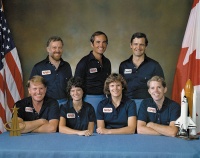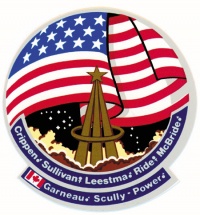STS-41G
From The Space Library
 | |
| Organization | NASA-OfficeofSpaceScienceApplications(UnitedStates),NASA-Office of Space Flight (United States) |
|---|---|
| Mission type | Communications,Earth Science,Human Crew |
| Launch date | October 5, 1984 |
| Launch vehicle | Space Shuttle |
| Launch site | Cape Canaveral, United States |
| COSPAR ID | 1984-108A |
| Experiments | Here |
| Alternate Names | OSTA 3/STS 41G,STS 13,15353 |
| Additional Information | Here |
| Data Collection | Here |
| Payload Mass Up | 10629.0 kg |
The 13th flight of the Space Shuttle (STS 41-G) carried the OSTA-3 (Office of Space and Terrestrial Applications) payload designed for conducting experiments in earth remote sensing. This experiment payload consisted of 1) a Shuttle Imaging Radar (SIR-B) for studies of the earth's surface, 2) a Large Format Camera (LFC) for cartographic mappings of the earth, 3) a Measurement of Air Pollution from Satellite (MAPS) experiment to determine the distribution of CO in the atmosphere, and 4) a Feature Identification and Location Experiment (FILE) for classification of surface materials. The SIR-B was an upgraded version of the SIR-A flown on the OSTA-1 payload during the STS-2 mission (NSSDC ID 81-111A-01). The MAPS and FILE sensors were the reflies of those same instruments on the OSTA-1 payload (NSSDC ID 81-111A-04 and 81-111A-03). The mission lasted 8 days and, except for SIR-B, all instruments met their prelaunch requirements.
Mission patch:

